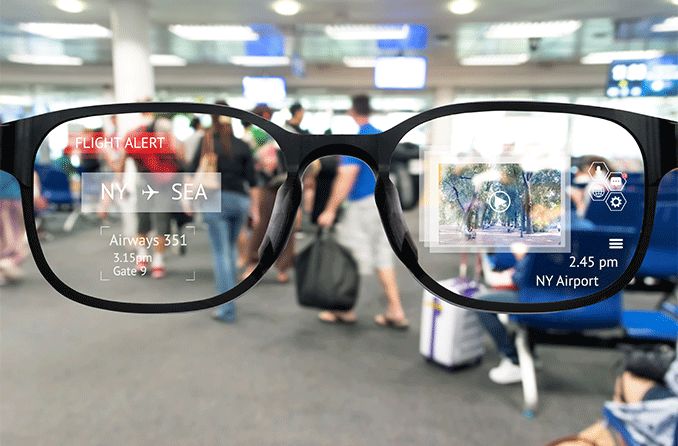The Dawn of Truly Ambient Computing: What to Expect from Next-Generation Smart Glasses
For years, the concept of smart glasses has oscillated between science fiction fantasy and niche technological curiosity. Early attempts were bulky, socially awkward, and functionally limited. However, the industry is on the cusp of a monumental leap forward. Driven by breakthroughs in micro-displays, AI processing, and battery technology, the next generation of smart glasses, anticipated to mature around 2026, promises to be less of a gadget and more of an integrated, ambient computing platform. This isn’t just an update to existing wearables; it’s a paradigm shift that will redefine our interaction with digital information and the physical world. This evolution in Wearables News signals a move from devices we consciously use to companions that seamlessly assist us. These future devices will merge the digital and physical realms, offering persistent, context-aware information overlays without requiring us to look down at a screen. The latest Smart Glasses News suggests that major players are moving beyond simple notifications and camera functions, aiming to deliver a true augmented reality experience in a socially acceptable form factor. This article explores the key technological advancements, potential applications, and critical challenges defining this exciting frontier in personal technology.
Section 1: Deconstructing the Next-Gen Smart Glass: The Core Technological Pillars
To understand the transformative potential of smart glasses circa 2026, we must first examine the core technologies that will make them possible. Unlike the bulky headsets of today, the goal is a device that is lightweight, stylish, and capable of all-day use. This requires a convergence of several key innovations.
Advanced Display Technology: The Window to a New Reality
The single most critical component is the display. The challenge is to project a bright, clear, and wide field-of-view image onto the user’s retina without a cumbersome apparatus. The leading contenders are advanced microOLED displays combined with sophisticated waveguide optics. Waveguides are microscopic structures etched into the lens that “guide” light from a tiny, side-mounted projector to the eye. The goal is to achieve high nits (brightness) for outdoor visibility, a resolution that makes text crisp and graphics sharp, and a field of view wide enough to feel immersive rather than like a small floating screen. Progress in this area is a hot topic in AR/VR AI Gadgets News, as it represents the primary barrier to creating a truly convincing augmented experience.
The Powerhouse Within: AI-Centric Processing on the Edge
Future smart glasses will not simply be a second screen for your phone; they will be powerful standalone computing devices. This necessitates a custom-designed System-on-a-Chip (SoC) optimized for low-power, high-performance AI computation. These chips will handle real-time sensor fusion, computer vision tasks, and natural language processing directly on the device. This “edge computing” approach is crucial for low-latency performance and privacy, as less data needs to be sent to the cloud. This trend in AI Edge Devices News is fundamental for creating responsive AI Companion Devices News that can understand and react to your environment instantly. The processor will be the brain behind the entire operation, enabling the glasses to function as a true visual assistant.
Seamless Connectivity and Sensor Fusion
To provide contextually relevant information, the glasses must understand both the user and their environment. This will be achieved through a sophisticated suite of sensors, including high-resolution cameras, LiDAR scanners for depth perception, accelerometers, gyroscopes, and multiple microphones for spatial audio. The latest AI Sensors & IoT News highlights the miniaturization and efficiency gains in these components. These sensors will work in concert, allowing the glasses to map the room, identify objects, and understand user gestures and voice commands. Connectivity via Wi-Fi 6E and 5G will ensure a persistent link to the broader digital ecosystem, from your smart home devices to cloud-based AI services.
Section 2: A Day in the Life with 2026 Smart Glasses: Real-World Applications
The true measure of this technology lies not in its specifications, but in its impact on daily life. By 2026, smart glasses will have moved beyond novelty to become indispensable tools for productivity, communication, and personal enrichment. Here are some concrete scenarios.
The Ultimate Personal and Professional Assistant
Imagine walking into a business meeting. Your glasses instantly recognize the attendees, pulling up their LinkedIn profiles and recent email correspondence, discreetly displayed in your peripheral vision. During the presentation, key data points are translated into real-time charts, and a live transcript is generated. This is the future of AI Office Devices News. At home, the applications are just as powerful. While cooking, a recipe can be overlaid directly onto your countertop, with timers and instructions appearing as you need them. This ties into the latest AI Kitchen Gadgets News and broader Smart Home AI News, as the glasses become a universal interface for all your connected devices. You could adjust your AI Lighting Gadgets News or check the status of Smart Appliances News with a simple glance and a voice command.
Revolutionizing Health, Fitness, and Accessibility
The potential in the wellness sector is immense. Your morning run could feature a virtual pacer, with your heart rate, distance, and calories burned displayed in a non-obtrusive overlay, representing a major leap in AI Fitness Devices News. These devices will offer real-time form correction for workouts, guided meditation with calming visuals, and even dietary feedback by identifying the food on your plate. This aligns with emerging trends in Health & BioAI Gadgets News. For accessibility, the impact is even more profound. The glasses can provide real-time audio-to-text transcription for the hearing impaired or use AI-enabled Cameras & Vision News to describe the world to the visually impaired, identifying obstacles, reading signs, and recognizing faces. This is a game-changer for AI for Accessibility Devices News.
Transforming Travel, Education, and Entertainment
Navigating a foreign city becomes effortless. Street names, directions, and historical information about landmarks appear as you look at them, while spoken language is translated into subtitles in real-time. This is the future of AI for Travel Gadgets News. In education, students could dissect a 3D model of a human heart on their desk or explore the solar system in their classroom, making learning interactive and engaging, a key focus of AI Education Gadgets News. Entertainment will also be redefined. Imagine watching a live sporting event where player stats hover above them on the field, a concept driving AI in Sports Gadgets News. The potential for interactive AI in Gaming Gadgets News is also boundless, turning the real world into a playable environment.
Section 3: Implications and Insights for the Broader Tech Ecosystem
The arrival of mature smart glasses will send ripples across the entire technology landscape, creating new opportunities and disrupting established markets. This is more than just a new product category; it’s the foundation for the next dominant computing platform.
The Shift from Mobile-First to AI-First

For over a decade, the smartphone has been the center of our digital lives. Smart glasses represent a fundamental shift towards an “AI-first” world. Instead of pulling out a device to seek information, information will be presented to us proactively and contextually by an ever-present AI assistant. This will change how we think about software and user interfaces, moving from touchscreens to a combination of voice, gestures, and gaze. This evolution is a core topic in AI Assistants News and will have a profound impact on AI Phone & Mobile Devices News, as the role of the phone may shift to that of a pocket-based server for the glasses.
A Catalyst for the Internet of Things (IoT)
Smart glasses will become the ultimate universal remote for the IoT. They will provide a seamless visual interface for interacting with a vast array of connected devices. Imagine looking at your smart thermostat to see and adjust the temperature, or glancing at your robotic vacuum to see its cleaning path. This intuitive interaction will accelerate the adoption of smart devices, from AI Security Gadgets News that can show you a live camera feed to AI Pet Tech News that lets you see through a camera on your pet’s collar. The glasses will unify the fragmented smart home experience, providing a single, cohesive control layer for everything from Robotics Vacuum News to AI Gardening / Farming Gadgets News.
The Rise of Spatial Computing and the Creator Economy
These devices will unlock the era of spatial computing, where digital content is not confined to a screen but is anchored to the physical world. This creates a new canvas for developers and artists. We will see a surge in demand for 3D content and AR experiences, fueling a new wave of the creator economy. The latest AI Tools for Creators News will focus on building intuitive platforms for designing these spatial experiences, from interactive art installations to AR-enhanced retail environments. This technology could even interface with other advanced systems, providing pilots with enhanced data from Drones & AI News or engineers with real-time diagnostics from complex machinery, pushing the boundaries of AI Research / Prototypes News.
Section 4: The Path to Adoption: Challenges, Considerations, and Best Practices
Despite the immense potential, the road to mass adoption is fraught with challenges. Overcoming these hurdles will be just as important as developing the technology itself.

Overcoming the Technological and Social Hurdles
- Battery Life: The biggest technical challenge is providing enough power for all-day use in a tiny form factor. Significant innovation in battery density and power efficiency is still required.
- Thermal Management: Packing a powerful processor and display into a small frame generates heat, which must be managed to ensure comfort and safety.
- Social Acceptance: The “glasshole” effect is a real concern. The design must be stylish and discreet, and there must be clear social etiquette, such as an obvious indicator light when the camera is recording, to address privacy fears. This is a critical aspect of AI in Fashion / Wearable Tech News.
- Privacy and Security: An always-on camera and microphone create significant privacy questions. Manufacturers must implement robust, transparent security measures to gain public trust. This is a central theme in discussions around AI Monitoring Devices News.
Tips and Considerations for Early Adopters
When these devices launch, early adopters should manage their expectations. The first mass-market versions will likely be impressive but still have limitations. It’s wise to focus on a few key use cases that solve a real problem for you, whether it’s hands-free navigation, real-time translation, or enhanced productivity. Consider the ecosystem; a device that integrates seamlessly with your existing phone, computer, and smart home will provide a much better experience. Finally, be prepared for a software-driven evolution. The hardware will be the foundation, but the capabilities will grow immensely over time through software updates.
Conclusion: The Inevitable Future of Human-Computer Interaction
The journey towards truly capable, all-day smart glasses is a marathon, not a sprint. The technological hurdles of power, display fidelity, and thermal management are significant, and the societal questions of privacy and acceptance must be addressed with care. However, the trajectory is clear. The developments we anticipate by 2026 will represent a pivotal moment, shifting smart glasses from a niche gadget to a foundational piece of personal technology. They promise a future of ambient computing, where information is seamlessly woven into our perception of the world, making technology more intuitive, helpful, and ultimately, more human. This evolution will not just change the devices we carry; it will fundamentally alter how we learn, work, and connect with the world around us, marking the next great chapter in the story of human-computer interaction.










